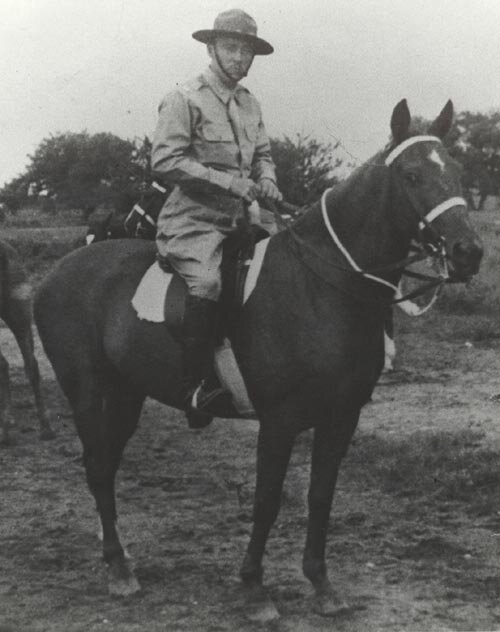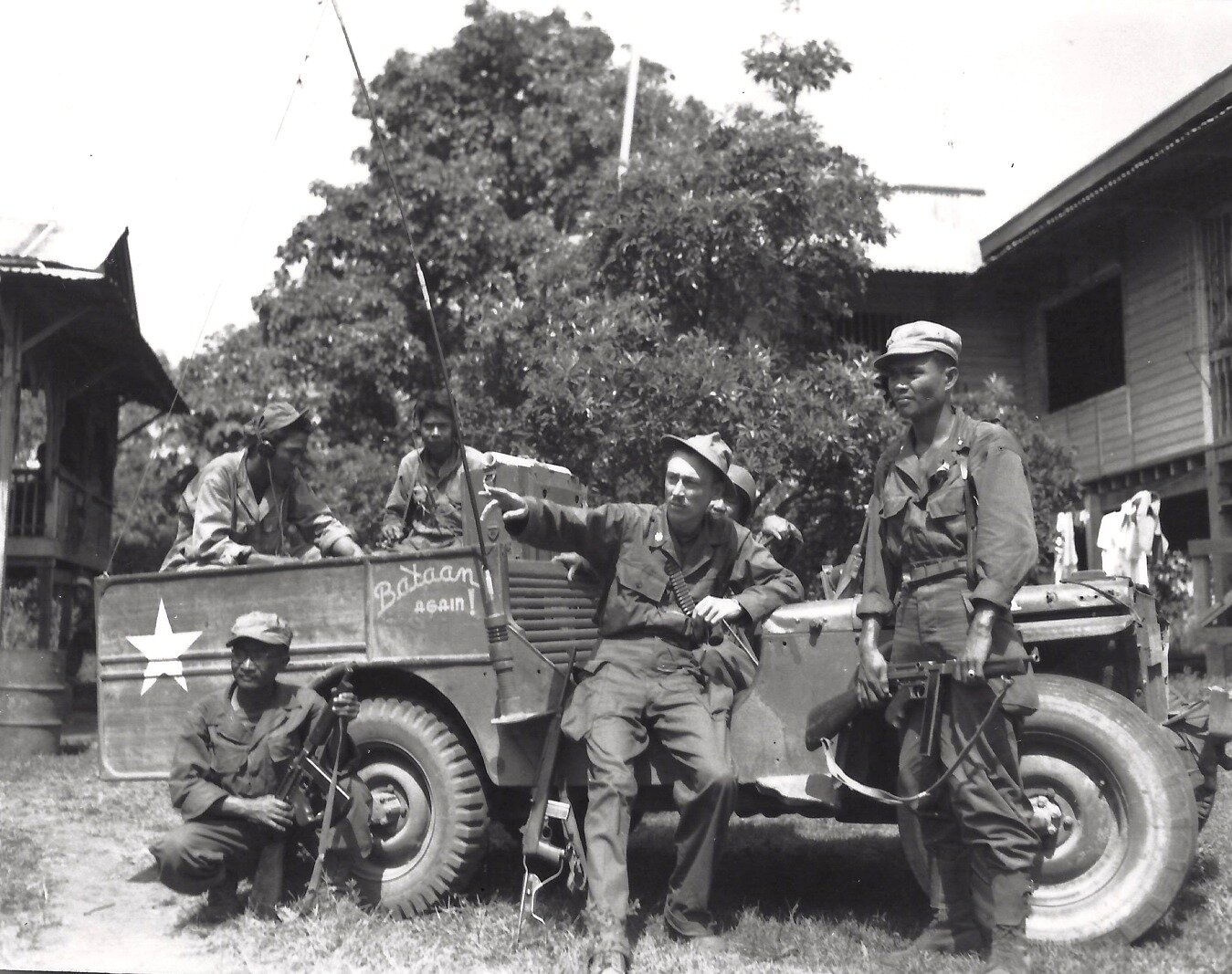In Memory of
Colonel Edwin Price Ramsey
26th Cavalry Regiment (PS)
May 9, 1917 - March 7, 2013
Then 1st. Lt. Ed Ramsey and his horse, Brynn Awryn.
Col. Ramsey with Maj. Claro Camacho, Chief signal officer of ECLGA with Radio Operators Cordero and Acosta and driver, Delfin Domingo with Jeep captured from the Japanese (edwinpriceramsey.com)
Col. Ramsey and his wife, Raqui.
By Elaine Woo, Los Angeles Times
Historians have said that losing the Philippines in the early stages of World War II was a defining event in the career of Gen. Douglas MacArthur.
The same could be said of Edwin Ramsey. But Ramsey couldn't admit defeat.
After MacArthur's retreat in early 1942, Ramsey, an officer in the 26th Cavalry Regiment of the U.S. Army, joined the Philippine resistance. He eventually headed a guerrilla force that grew to 40,000 enlisted men and officers, supplying crucial intelligence that helped lay the foundation for MacArthur's triumphant return more than two years later.
He had proved his mettle months before MacArthur's departure, when he led the last mounted cavalry charge in U.S. military history — a courageous action that disrupted the Japanese invasion long enough for American and Philippine forces to pull back.
Ramsey, 95, whose World War II exploits earned him the Distinguished Service Cross personally awarded by MacArthur, died of natural causes March 7 at his Westwood home, said his son, Douglas Ramsey.
Enduring malaria, malnutrition, dysentery and an appendectomy without anesthesia during his service with the Philippine resistance, he received honors from several Philippine presidents and was revered in the Filipino American community.
"Next to MacArthur, he is No. 2," said Eugene Orias Jr., a Filipino American who met Ramsey through a local chapter of the Veterans of Foreign Wars. "He was able to stay behind enemy lines while the country was under Japanese rule. When the general came back, he was able to give him the straight story of what happened."
As the Japanese Imperial Army landed thousands of soldiers near Manila Bay in January 1942, the 26th Cavalry was ordered into the fray to delay the enemy's advance. Ramsey, then a lieutenant, led 27 riders to the strategic coastal village of Morong.
The village was still as Ramsey entered, but a Japanese advance guard soon shattered the silence with guns blazing. When Ramsey spied hundreds more Japanese troops wading across a river toward him, he knew his men had only one hope for survival.
He raised his pistol and, like a long line of cavalrymen since Custer's time, hollered, "Charge!"
"Bent nearly prone across the horses' necks, we flung ourselves at the Japanese advance, pistols firing full into their startled faces," he recalled in "Lieutenant Ramsey's War," a 1991 memoir co-written with Stephen Revele. "A few returned our fire, but most fled in confusion.... To them we must have seemed a vision from another century, wild-eyed horses pounding headlong; cheering, whooping men firing from the saddles."
After repelling the invaders, Ramsey and his platoon held their position for five hours under heavy fire until reinforcements arrived.
"This gallant little band of horsemen had maintained the best traditions of the American Cavalry," Gen. Jonathan Wainwright, then a senior field commander under MacArthur, wrote in his official report on the battle. "I doubt if I could have successfully made that withdrawal" without them.
But over the next weeks the Japanese army regrouped and pushed American and Philippine forces farther south. Rampant disease and starvation also sapped U.S. strength.
The food situation was so dire that all horses belonging to the 26th Cavalry were ordered slaughtered. Ramsey learned of the demise of his beloved chestnut gelding, Bryn Awryn, while recovering from a leg wound in a field hospital, and bore the indignity of riding back to the battle lines in a truck. (The last mounted units were dissolved after the war.)
When the American defense of Bataan collapsed in spring 1942, Ramsey found himself cut off from his unit. Avoiding the fate of thousands of prisoners who died at Japanese hands during the Bataan Death March, Ramsey fled to central Luzon and signed up with Col. Claude Thorpe, who was organizing resistance fighters.
For the rest of the war, Ramsey led a scrappy Filipino militia of 40,000 irregulars who armed themselves with weapons taken from dead soldiers. Ramsey later told the Winston-Salem Journal: "We made arms out of sawed-off pipes that we used as shotguns."
His guerrilla force — one of about a dozen on the islands — also gathered intelligence and conducted "counter-propaganda" efforts, including publishing a newsletter. They fanned Filipinos' hopes for liberation by distributing packs of cigarettes and chocolates sent by MacArthur's staff printed with his famous last words: "I will return."
Near the end of the wait for liberation forces, Ramsey made do with a bottle of rum to numb the pain of emergency surgery for appendicitis. He weighed only 93 pounds when MacArthur's Sixth Army arrived in early January 1945.
Edwin Price Ramsey was born May 9, 1917, in Carlisle, Ill., and grew up in Kansas. His father hanged himself in jail after being arrested on suspicion of battering his wife. His mother, a dermatologist who later ran her own clinic, raised Ramsey and his older sister, one of the first female pilots to deliver the U.S. mail.
A rambunctious teenager, Ramsey was sent to the Oklahoma Military Academy, where his love of horses found an outlet on the polo team. He went on to the University of Oklahoma, which had a horse artillery unit, but left to join the Army in 1941.
After the war, he returned to the university for a law degree and worked in Japan for Hughes Aircraft as vice president of its Far East division. According to his son, Ramsey helped Hughes secure a contract to build the satellite that broadcast the 1964 Summer Olympics from Tokyo to the world. He became friends with several Japanese military leaders involved in the bombing of Pearl Harbor, including Minoru Genda, the Japanese naval commander who planned the attack.
Ramsey later ran electronics and consulting firms in Taiwan and the Philippines until retiring to Los Angeles in the 1990s.
His first marriage, to Madeleine Willoquet, ended in divorce in the late 1970s. He is survived by his second wife, Raquel Ramirez; four children from his first marriage, Edwin Jr., Douglas, Michele and Janine; four grandchildren and three great-grandchildren.
Ramsey often said he didn't expect to survive the war. And although he played an important role in the victory, he was loath to take much credit.
"I look back and think of myself as a soldier, not as a hero," he told a reporter from British Columbia in 2001. "I just had a temperament that made it impossible for me to surrender."
For more information on Colonel Edwin Price Ramsey, please visit EdwinPriceRamsey.com.


